If the Lumix G7 is the mid-range model within Panasonic’s SLR-styled family, the Lumix GX85 (otherwise known as the GX80 or GX7 II depending on where you live) could easily be called its counterpart within the rangefinder line-up. Despite the one-year age gap and the difference in design, they actually have much in common in terms of their specifications.
In addition to sharing a very similar 16MP Micro Four Thirds sensor, both cameras have a built-in electronic viewfinder, employ a contrast detection autofocus system called Depth from Defocus, shoot 4K video, and benefit from various 4K Photo modes.
There are however a few key differences that set these two models apart. In this comparison, our aim is to investigate these differences and in the process, discover which is more appropriate for your style of shooting. Let’s get started!
[toc heading_levels=”2″]
Ethics statement: We were provided with a samples of the Panasonic G7 whereas the GX85 is part of our personal collection. We were not asked to write anything about the lenses, nor were we provided with any sort of compensation. Within the article, there are affiliate links. If you buy something after clicking the link, we will receive a small commission. To know more about our ethics, you can visit our full disclosure page. Thank you!
Design, Ergonomics and Ease of Use
The first and most physically obvious difference is the size and design of the two cameras. Specifically, the G7 has the appearance of an SLR while the GX85 more closely resembles a rangefinder.
The G7 is the larger of the two owing to the substantial grip and fake pentaprism that houses its electronic viewfinder. If you removed these two characteristics, it would actually be very similar in size to the GX85. It measures 124.9 x 86.2 x 77.4 mm and weighs 410g with the battery and SD card.
With dimensions of 122 x 70.6 x 43.9 mm, the GX85 cannot be called pocketable but it is compact enough to slip inside a small bag or jacket pocket when paired with a small prime lens. Surprisingly it is a little heavier than the G7 at 426g. Since the grip is much smaller, it isn’t quite as comfortable to hold for long periods of time as the G7.
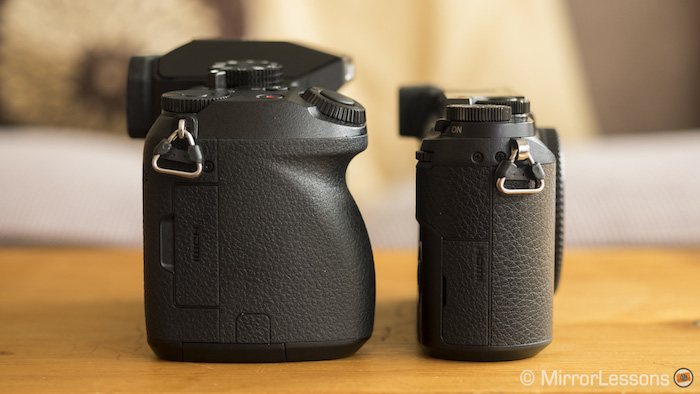
Since the G7 is larger, Panasonic was able to give it four dials instead of just three. They both have a PSAM dial and two control dials to change the exposure, but only the G7 has a drive dial that gives you direct access to the burst shooting, 4K photo, bracketing, timer and time lapse modes.
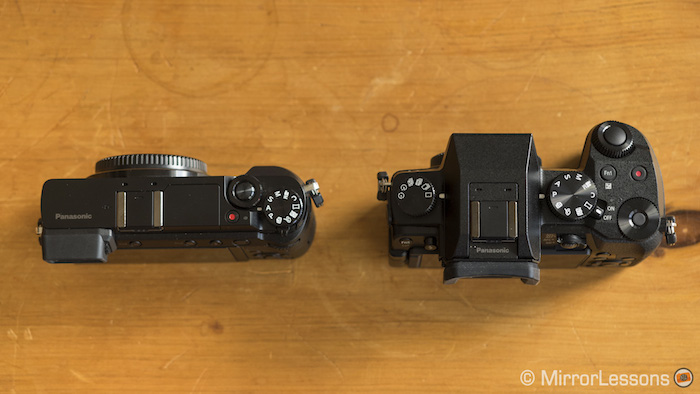
On the G7, there are six physical function buttons and another five virtual buttons found within a pop-out bar on the touchscreen. Although it has the same number of virtual buttons, the GX85 only has room for four physical function buttons. These buttons can be customised with your preferred settings in shooting and playback mode.
Curiously only the G7 has the extremely handy focus switch that lets you rapidly switch between AFS, AFF, AFC and MF without entering the menu. We personally feel that Panasonic could have given the GX85 a similar switch and placed it on the left-hand side or front of the body.
Both come with a dedicated movie button but neither is particularly easy to reach or press. On either model, it makes much more sense to switch to Movie mode on the PSAM dial and use the shutter button to start/stop recording.
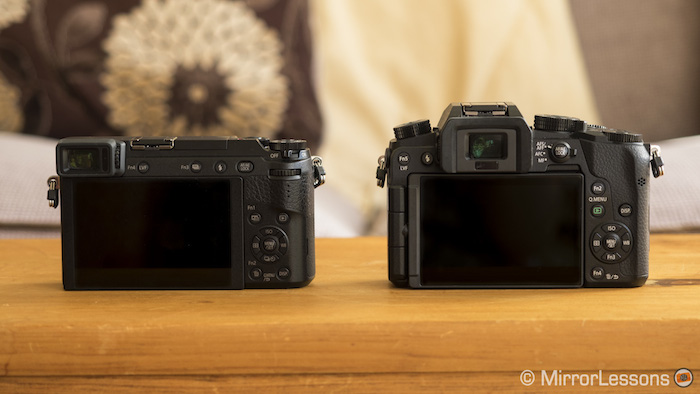
Tilting LCD screens have become a staple of interchangeable Lumix cameras and the G7 and GX85 are no exception. Although both have a 3-inch 1040K-dot monitor, the G7’s screen is a free-angle type, making it better suited to serious video work, while that of the GX85 only tilts up 90 degrees and down 45 degrees. Happily, both are touch sensitive, so you can easily choose your focus point, swipe through your photos or browse through the menu without touching a single button.
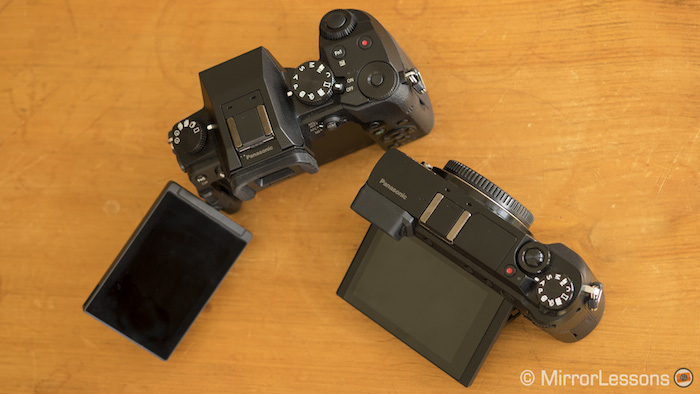
There are also a number of differences between their respective electronic viewfinders (EVF).
The most noticeable is the position: that of the G7 is located in the centre within a fake pentaprism and is cushioned by a large eyecup, while the GX85’s is found on the left-hand side of the body and has a smaller eyecup.
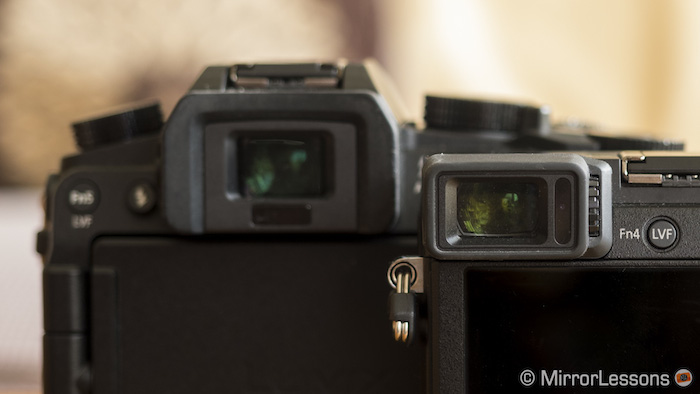
Second we have the panel itself: the G7 has an OLED panel with 2360K-dots of resolution while the GX85’s LCD panel has 2764K-dots of resolution. It may sound as if the GX85 has more resolution but since the EVF uses field sequential technology, the actual resolution is closer to 922K-dots.
The aspect ratio of their respective EVFs is also different: 4:3 on the G7 and 16:9 on the GX85. This means that when you shoot stills with the 4:3 aspect ratio on the GX85, the image looks smaller than when you shoot with the 16:9 aspect ratio. They share a magnification factor of 0.70x, 100% field coverage and a maximum refresh rate of 60fps.
In use, the G7’s finder is more comfortable to look through for extended periods thanks to its size, eyecup and bright OLED screen. Note that you pan quickly with the GX85, you may notice some rainbow artefacts within the finder due to the field sequential technology.
Both cameras have a built-in pop-up flash. That of the G7 sits on top of the fake pentaprism while the GX85’s is located in between the hot shoe and the main dials.
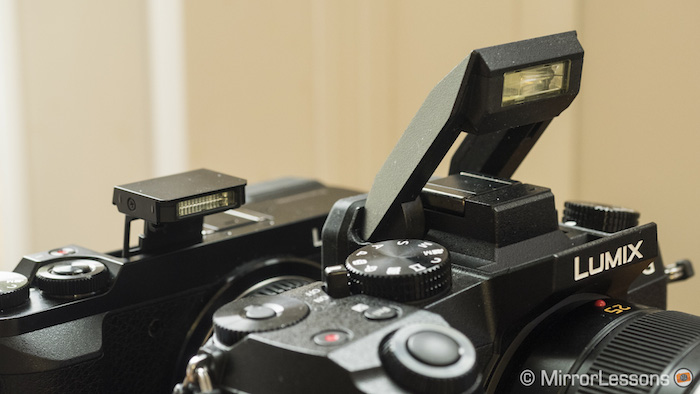
The menu of the two cameras is also identical, give or take a few extra functions found on the GX85 which we’ll discuss later on. It is colourful, user-friendly and well-organised and can be browsed with either the buttons/dials or your finger thanks to its touch sensitivity.
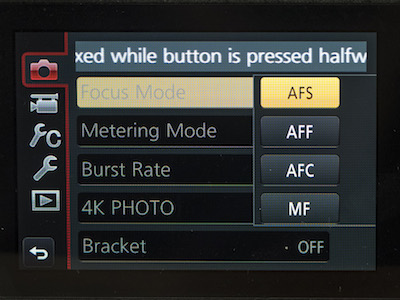
As for the various ports, both have an HDMI output but only the G7 has a microphone input (3.5mm) and an AV/Out Digital output. In their place on the GX85, you’ll find a USB port that can be used to charge the camera.
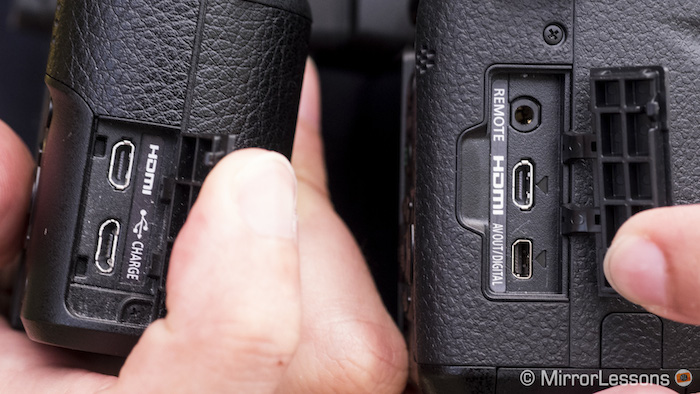
I’ve saved one of the most significant differences for last: the shutter mechanism. The G7 features an older version of Panasonic’s shutter mechanism which is unfortunately prone to shutter shock between 1/60 and 1/320 of a second.
The GX85, on the other hand, is the first Lumix camera to feature an updated shutter mechanism with an electronic magnetic drive, and is said to reduce shutter shock by around 90%. I cannot confirm this exact percentage but in use, it does seem to do an excellent job of suppressing all shutter shock regardless of the lens or shutter speed used.
If you find shutter shock to be a problem on the G7, you can always activate the electronic shutter. In fact, both cameras have an electronic shutter option that works up to 1/16000 of a second.
Image Quality: The sensor
The 16MP Micro Four Thirds sensor of the G7 and GX85 would be identical if not for one small difference: the GX85’s lacks an anti-aliasing filter, also known as a low-pass filter. The job of this filter is to reduce moire and false colour but in doing so, it can also slightly blur the finest details in your image.
In practice, we should see a little more sharpness from the GX85 files compared to the G7 – Panasonic claims an increase of 10% in resolution. To see if this is the case, let’s have a look at a pair of side-by-side images taken with the Lumix 42.5mm f/1.7 featuring a teddy bear covered in fine hairs and minute holes.


As you can see from the 100% crops, the GX85 are marginally sharper but it is a challenge to decipher any relevant differences.
The dynamic range and high ISO performance appears to be more or less identical, which isn’t a surprise since we are talking about the same sensor.


I did notice a little more colour noise from the GX85 at the highest ISO values (6400 – 25600) but the difference is barely visible.
A small curiosity is that Auto WB of the G7 and GX85 appear to be calibrated differently, with the GX85 producing warmer tones than the G7.
This difference remains even if you switch over to a specific Kelvin value, though it is a little less pronounced.
You may also notice that the GX85 has an extra Photo Style in addition to Standard, Vivid, Natural, Monochrome, Scenery, Portrait and Custom Standard. This style, called L.Monochrome, is meant to deliver deep blacks with rich gradation that imitate the look of black and white film. Compared to the standard Monochrome profile, it provides better overall contrast even if you don’t tweak any of the settings.


Autofocus, Manual Focus and Performance
Both the G7 and GX85 share the same contrast detection autofocus system with Panasonic’s Depth from Defocus (DFD) technology. To quote Panasonic:
“It instantaneously calculates the distance to the subject by evaluating two images with different sharpness levels. Calculated distance data allows instant focusing with two detection cycles for much faster operation than conventional Contrast AF.”
This technology only works with compatible Lumix G lenses. You can find the full list here.
Having used the G7 and GX85 for a number of sports events, we find that they are both capable of tracking predictable subjects moving at a slow to medium pace but are less reliable for high-speed action or very unpredictable subjects.
For serious action photography, hybrid phase/contrast detection autofocus systems such as those of the Sony a6300 or Fujifilm X-T2 deliver more consistent results.
The focus detection area features 49 points from which you can select blocks of points depending on the autofocus mode you are in. These autofocus modes are:
- 49-Area – Activates all 49 points across the screen. Good for unpredictable subjects.
- Custom Multi – Activates specific points that you choose. Good for predictable subjects and groups.
- 1-Area – Choose one point whose size you can reduce or enlarge. Good for small or static subjects.
- Pinpoint – Choose a very specific point. Good for small details and macro.
- Tracking – Track a moving subject.
- Face/Eye Detection – Allow the camera to lock onto the face or eye of the subject. Good for portraits.
We tend to use Custom Multi and 1-Area more than the others because they provide the most flexibility.
With the mechanical shutter, both cameras can shoot up to 8fps in AFS and 6fps in AFC. This increases to 40fps (Super High) with the electronic shutter. Live View with blackouts is only available up to 6fps while at 8fps the camera shows the last picture taken in rapid sequence.
The shutter speed range of both cameras is 60s – 1/4000s with the mechanical shutter and 1s – 1/16000s with the electronic shutter. The electronic shutter is completely silent but should only be used for non-moving subjects as movement can result in rolling shutter artefacts.
Between the two, the GX85 has the deeper buffer. Below are the results after testing both at 6fps in AFC with the Lumix G 35-100mm f/2.8 and a SanDisk Extreme Pro memory card (95MB/s):
- Lumix GX85 – 46 shots (RAW+JPG) / Did not slow down with JPGs
- Lumix G7 – 16 shots (RAW+JPG) / 53 shots (JPG) before it slowed down
Usefully, when you half-press the shutter release, the GX85 displays the number of shots available in a burst at the bottom left-hand corner of the screen, while the G7 only displays the remaining shots that can fit onto the memory card.
Below you can find some example images taken with both the G7 and GX85 at a local marathon. The runners were moving in a straight line at a medium pace in good light, so the cameras had little difficulty following them.




Below you can also find two example series of Mathieu running towards me. Both cameras were set to AFC/Medium burst (6fps)/JPG with the nine central points selected (Custom Multi). Green means in-focus, yellow means slightly out-of-focus, and red means out-of-focus.
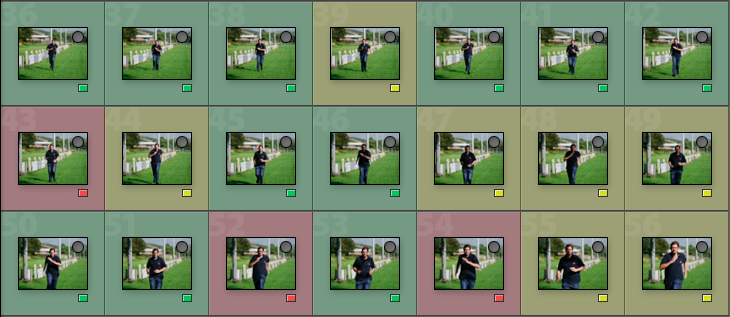

Both cameras also feature Starlight AF which allows them to focus on subjects with more precision down to -4EV in situations with very poor light, such as a star on a dark night.
Manual focus is easy on both cameras thanks to assists such as focus peaking and magnification. We personally prefer the latter as it gives a more precise view of the area you want to bring into focus.
In-Body Stabilisation
If I had to list one reason to purchase the GX85 instead of the G7, this would be it. The GX85 is the first Lumix camera to benefit from 5-axis in-body stabilisation that works with all lenses including those from Panasonic Lumix, Olympus M.Zuiko and third-party manufacturers.
Even more interesting is that when you pair the GX85 with select Lumix G lenses with optical stabilisation (O.I.S.), you gain access to Panasonic’s Dual IS stabilisation system which, in some cases, is even more effective than the in-body stabilisation on its own.
At telephoto lengths in particular, it is possible to take sharp shots at 100mm (200mm in full-frame terms) at speeds close to 1 second if you remain very steady – something that would be impossible with just in-body stabilisation. With the in-body stabilisation on its own, 1 second exposures are possible with wide-angle lenses (though it requires many attempts).


Filmmakers will be pleased to know that the in-body stabilisation, including Dual IS, works for video as well. However, it is more effective for static shots than panning or walking due to distortion, rolling shutter and jello-like effects.
Below you can watch an in-depth video that shows the capabilities of the GX85’s stabilisation in comparison to the Olympus Pen F, one of its direct competitors in terms of stabilisation.
Since the G7 lacks all in-body stabilisation, the user must rely on the optical stabilisation of certain Lumix lenses. If you use it with non-stabilised lenses, it is important to be aware that shutter speeds under 1/100 of a second may not be perfectly in focus.
Video
The respective video modes of the G7 and GX85 have much in common, such as the ability to shoot in 4K (UHD 3840 x 2160) at 24/25/30fps at 100Mbps in MP4 mode, as well as the inclusion of features such as zebra pattern, focus peaking and display markers.
That said, there are a few differences that could tempt video shooters one way or the other.
The first regards the HDMI feed. Although both the G7 and GX85 can deliver a clean 4:2:2 8-bit 4K feed via the HDMI port to an external recorder, the G7 isn’t capable of simultaneously recording 4K to the SD card internally and outputting 4K through the HDMI port like the GX85. This also means that when the G7 is connected to an HDMI device, the live view on the camera’s monitor is disabled.
What’s more, the GX85 enjoys the aforementioned in-body stabilisation, so you can easily record footage hand-held in a pinch with all sorts of lenses – manual glass included. You just need to remember to enter the focal length manually to make sure the camera stabilises the image correctly.
Don’t let this put you off the G7 however: it has the advantage of CineLike D and V profiles, just like the flagship GH4. The former profile captures a wider dynamic range, producing low-contrast footage, while the latter has more contrast. Note that neither is a real log gamma curve but the Cine-Like profiles can give you more dynamic range to work with. You can also adjust highlights, shadows and contrast.
Both cameras suffer from rolling shutter in a similar way. Continuous autofocus is reliable for slow movements but can take some time to react in some situations. For action and sports, neither camera is capable of following a subject, with the G7 performing worse than the GX85.
To see how the two cameras perform for video recording, you can check out the brief comparison video below:
The G7 is the only model to have a 3.5mm microphone jack for audio recording, though both lack the all-important headphone jack.
Both have extra video-related features such as stop motion animation, time-lapse and snap movie with pull focus/fade options but only the GX85 offers 4K Live Cropping whereby you extract Full HD crops and pans from 4K footage. You can see how it works in the dedicated video below.
Extra Features
All Panasonic Lumix cameras tend to be extremely feature-rich, and the G7 and GX85 are just two of the latest examples. Beyond the various video-related features mentioned above, there is also a plethora for still photography.
Take for example the three 4K PHOTO modes – Burst, Burst S/S and Pre-Burst – that were introduce on the G7 and later passed on to the GH4, GX8 and GX85. These modes allow you to shoot a 4K video at 30 frames per second, select the perfect moment, and extract it as an 8MP JPG file that is then saved in-camera. It works well when you want to capture fleeting moments, such as the dragonfly and butterfly taking off in the two examples below.


Burst captures a continuous stream of footage when you hold down the shutter button, Burst S/S starts recording when you press the shutter button and stops when you press it again, and Pre-Burst captures the 30 frames before and after you press the shutter button.
Although both the G7 and GX85 have 4K PHOTO, it is accessed from different places on the body. On the G7, it has its own place on the Drive dial while on the GX85, it has been given a dedicated button which doubles up as a function button.
Two additional 4K PHOTO features, also only available as 8MP JPGs, are Post Focus and Light Composition. Post Focus enables users to select in-focus area even after shooting, while Light Composition produces a continuous 4K stream but only adds the brighter pixels to the composition, making it useful for star trails, fireworks and light painting. The former is found on both cameras (via firmware update on the G7) while the latter is currently limited to the GX85.

Both cameras can take multiple exposures and a panorama option is directly accessible from the mode dial.


Battery Life
The batteries of both cameras can easily last a day of shooting if you don’t use any of the high-end features such as 4K video or 4K PHOTO and adjust the settings so that the camera minimises battery power consumption. However, to be safe, it is always a good idea to have an extra battery on hand or, in the case of the GX85, an external USB charger like the Anker Mini.
The G7’s battery (DMW-BLC12E) is larger than the GX85’s (DMW-BLC10E) and comes packed with a dedicated external charger. The GX85 is bundled with an AC adapter for in-camera charging via the USB port. If you want to charge the battery externally, the only option is to buy a separate charger.
Price
As of late 2016, the GX85 is slightly more expensive than the G7 since it is the more recent product. While the GX85 costs in the region of $800 with the kit lens (12-32mm), the G7 is around $700 with the 14-42mm and can be found for even less second-hand.
Conclusion
Up until recently, the G7 was the Panasonic Lumix camera that many reviewers called the most affordable path into the 4K market. Now, at only $100 extra, we have the GX85 which not only incorporates nearly all the features of the G7 but also introduces a few important ones of its own.
Which should you choose? Well, the answer is much simpler than you might believe. In the end, it all comes down to ergonomics and stabilisation.
The GX85 is an excellent choice if you’re after something small and portable that can easily be stored inside a camera bag as a back-up or for trips where you want to pack light. Plus its 5-axis in-body stabilisation is ideal for those who do lots of filming but don’t want the encumbrance of a tripod or gimbal.
On a personal note, it was for these very reasons that we bought ourselves a GX85 for our YouTube channel. Its size lets us travel light when we attend photography events and it speeds up our workflow because we don’t have to stabilise our footage in post-production.
However there is definitely something to be said for the SLR-like ergonomics of the G7: it is more comfortable to hold for long periods of time, especially with long lenses, not to mention that the fully articulating screen is extremely useful for monitoring your footage and filming at various angles.
Although the lack of in-body stabilisation is a shame, you can still benefit from the O.I.S. of certain Lumix G lenses. And we mustn’t forget that regardless of whether your camera has in-body stabilisation or not, the best way to assure yourself of stable video footage is to use a good tripod.
Choose the Panasonic GX85 if:
- you prefer rangefinder styling with the EVF on the left
- you need a very compact solution that you can take with you wherever you go
- you do lots of hand-held still and video shooting
Choose the Panasonic G7 if:
- you prefer the ergonomics of an SLR-like body
- you feel you could take advantage of the CineLike profiles for video
- you require a mic input
- you like the idea of a fully-articulating screen
Check price of the Lumix GX85 / GX80 on
Amazon | Amazon UK | eBay | B&H Photo
Check price of the Lumix G7 on
Amazon | Amazon UK | B&H Photo | eBay
Second-hand Panasonic cameras on
Sample images










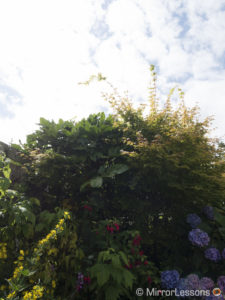




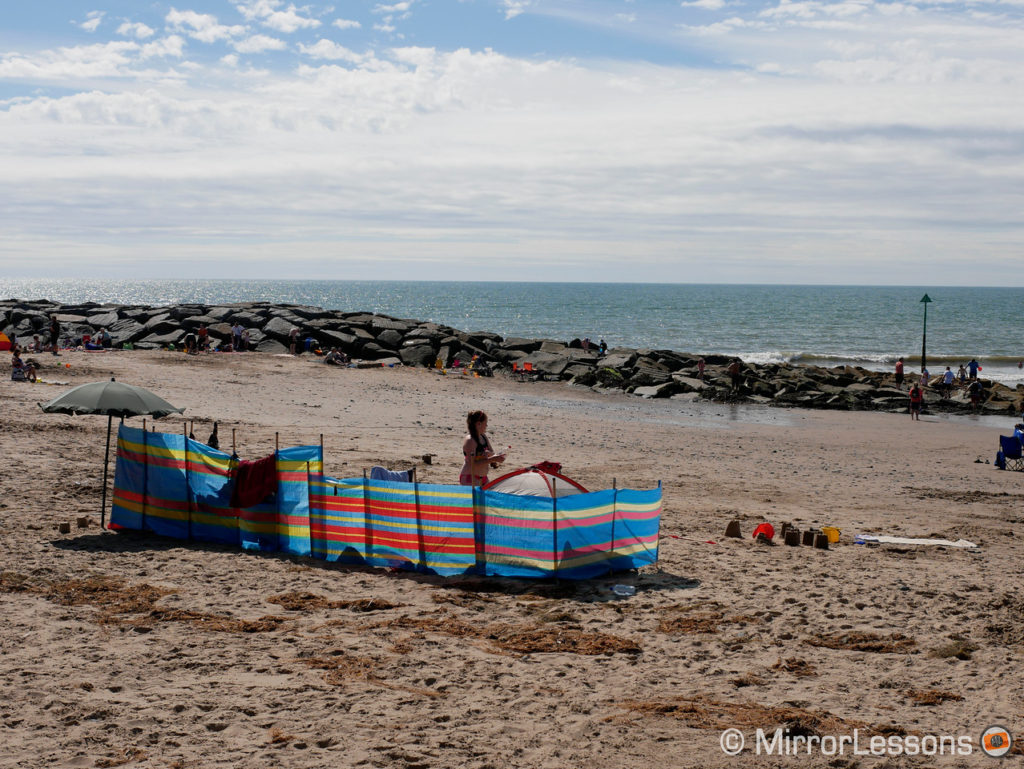
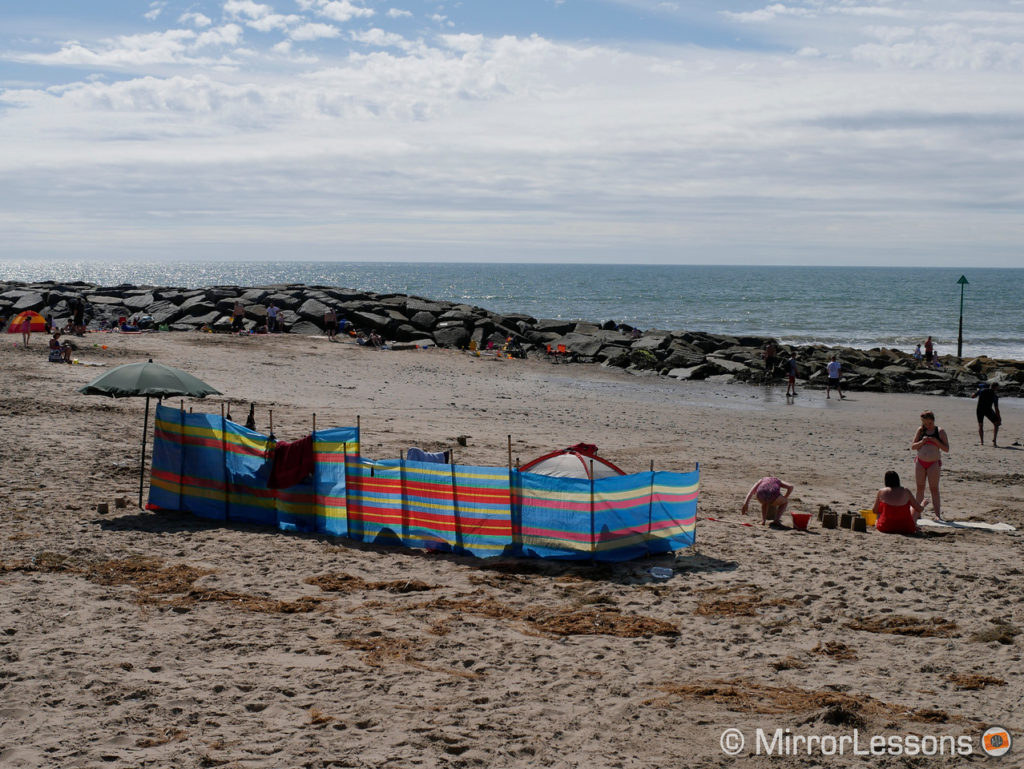
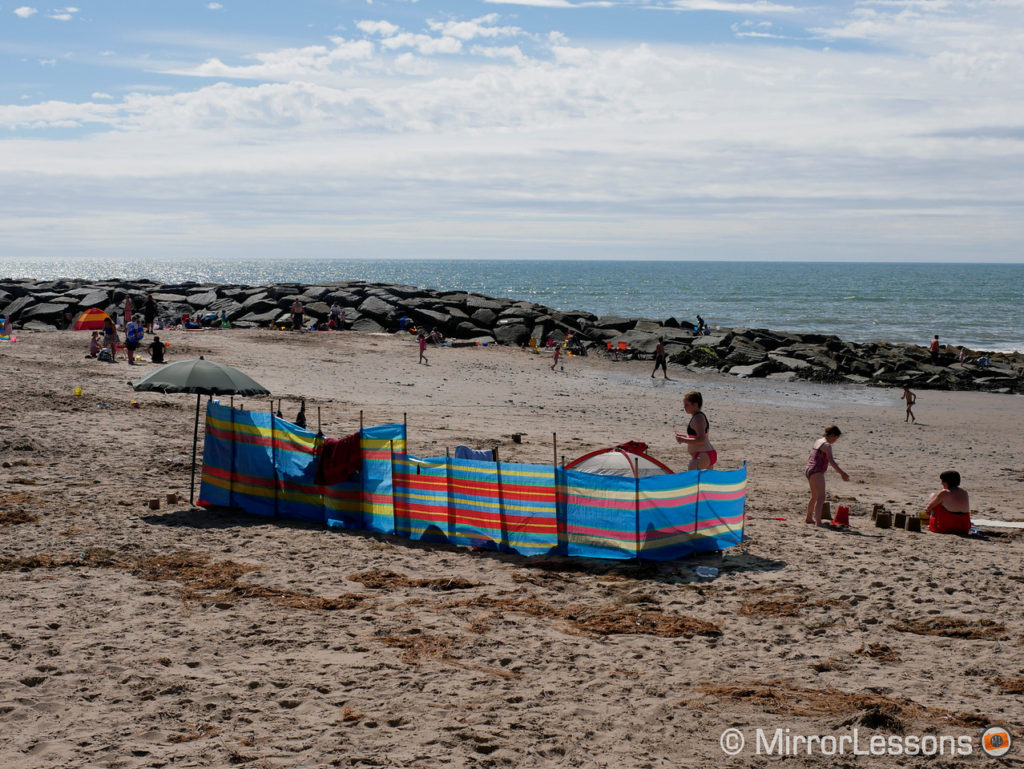

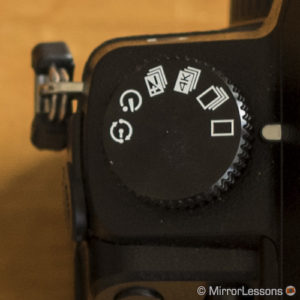
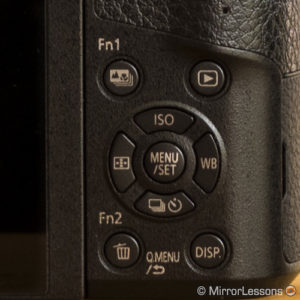
Great detailed review – thanks. Looks there a new model (G80?) on the way which will have the G7 body style and the GX85 features and in-body stabilization.
It sounds like the best of both worlds if the rumours are true!
This is the best comparison out there. Can’t think of anything they missed. Very well written, good job!
Thanks, Nami. Glad you enjoyed it!
Hi – enjoyed this review and all your reviews in general – seem to be more clearly written and aimed more toward users rather than gear geeks.
I do want to question what you said about the buffers, i.e. that the GX85 has the deeper buffer – the numbers you posted don’t seem to support that – were they reversed?
I would also like to respectfully suggest that you move on from the “fake pentaprism” descriptor for the viewfinder hump in G7 style cameras.
We are a long way and many years down the road into mirrorless now and compare/contrast descriptions with DSLR technology is getting a bit stale.
The hump is the housing for the electronic viewfinder and is the only place they can put the eyepiece if you are going to have a centrally located EVF.
May I suggest “viewfinder housing” or just simply “viewfinder” to describe that part of the camera body. It sounds better, it feels better and it doesn’t reference outdated technology that our cameras thankfully don’t have.
(Even “mirrorless” should go eventually, IMHO, though none of the suggested replacements so far seem very charismatic and have certainly not caught on.)
Anyway, thanks for your good reviews and informative website.
Aloha, Stephen
Yes, they should be reversed – thank you for noticing! As for the viewfinder, I’ll take your suggestion into consideration for future comparisons. Glad you are enjoying the new site!